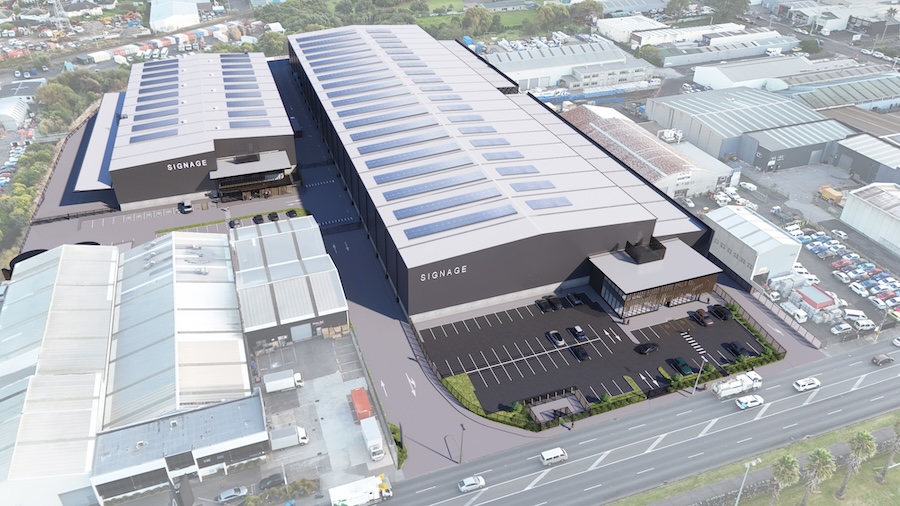A $100 million-plus industrial complex under construction in a historic trading area of Auckland is set to create a new standard for the sustainable distribution of goods in New Zealand.
Industry data shows the Auckland region has the lowest levels of industrial development for over a decade. At the same time, latest Stats NZ data shows the transport and warehousing sector makes up 6 percent of the total emissions of New Zealand’s industries.
The new industrial complex is targeting the 6 Green Star Design and As-Built rating, a world-leading sustainability standard.
The 3.5ha Neilson Street development in Auckland’s Onehunga, with an expected value on completion of over $100 million, will be the largest industrial build to date for NZX-listed Argosy Property Limited when completed in late 2025.
Architects will incorporate low-carbon concrete, rainwater harvesting, solar electricity generation, smart lighting, and smart air conditioning, among other green initiatives to help achieve the rating.
With approximately 1,750 solar panels generating over 1.2GWh of energy annually, the facility will also be one of NZ’s largest rooftop photovoltaic installations.
The site’s infrastructure will provide the capacity to accommodate large EV truck charging, with solar panels supplying over 1.2GWh of energy annually for next-generation electrified 23-metre truck and trailers – as well as for use in industrial processes or automated logistics.
Simon Brake, Argosy’s development manager, says the Onehunga development is attracting interest from- large-scale organisations focused on logistics and distribution and is likely to employ over 170 workers and a further 450 staff in its construction.
“Onehunga’s strategic central position as a port and transport hub between Auckland and the Waikato was first recognised hundreds of years ago and has seen it utilised as one of New Zealand’s earliest centres of trading and distribution.
“Today, these transit pathways are still in place and the location provides access to State Highway 20, State Highway 1 and the wider transport network – facilitating the movement of thousands of tonnes of goods for the domestic and export markets.
“With decarbonisation driving industry towards more sustainable business practices a prime location must be paired with a demonstrably sustainable building to attract large scale logistics operators.
“To meet the needs of this sector, we are integrating a range of energy and resource-efficient features into our building designs.
“These include the use of low carbon additives in concrete and onsite electricity generation – supporting tenants in the move to electrified transport by providing carbon-zero energy.
“In addition, rainwater tanks at the new development will store 980,000 litres of rain annually, enough to supply an average Aucklander’s daily needs for over 18 years. This supply provides an alternative to the utilisation of public water resources for non-potable use such as bathrooms and irrigation.
“We are also planning to use low-carbon steel as an alternative construction material.
“From an energy management perspective, and in contrast with commercial offices, lighting is expected to be the largest power consumer in an industrial building. We have consequently elected to install advanced LED systems that consume less than 2.5 W/m2 and will activate only with occupancy and insufficient natural light,” he says.

Simon Brake.
Brake says latest industry data shows industrial vacancy in central Auckland is low for A-grade warehouses and the committed supply pipeline of new developments for 2025 is just 61,000m2 – significantly lower than historical annual averages for the area
He says the Onehunga development has heavy industry zoning, dual road access and connections to local seaports, the CBD and Auckland airport and will be made up of two high clear span warehouses up to 13m in knee height – the first to be completed will be 5,000m2, and the second which is 11,500m2, as well as 3,400m2 of breezeway.
“We acquired the site four years ago and even within that time, we have seen significant movement in demand. The pandemic has seen the return of manufacturing from offshore and industrial businesses are increasingly looking for ways to green their operations. At the same time, construction costs have increased as has the cost of capital – which has significantly reduced supply of new product in the sector.
“With market data showing there is less than one percent prime industrial vacancy at the moment and forecasts showing next year could have the lowest new build volumes in over a decade, we have a high level of confidence in creating a pipeline of development that caters to sustainable industrial or logistics businesses,” he says.
Brake says Argosy owns 51 commercial and industrial sites valued at over $2 billion, including one-third of all redeveloped 5 Green Star Built rated (or higher) office buildings in NZ.




